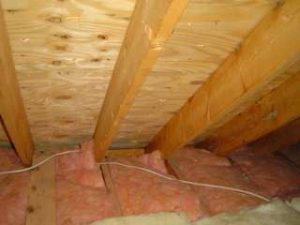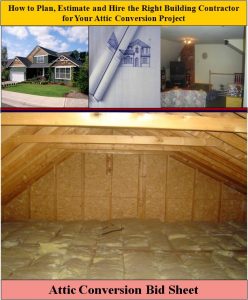Frost in the Attic is a sign of Moisture Problems
By Mark J. Donovan
|
|
If you have ever gone up into your home’s attic during a frigid winter day and have observed frost on the roof sheathing or roof rafters, then you have a moisture problem in your attic. Moreover, it also tells you that that you have an insulation and home heating efficiency problem. Consequently, you need to resolve the circumstances that are causing the frost to form in the attic. Frost forming in your attic should be rectified because the frost can lead to mold and mildew growth, both of which can negatively affect the health of you and your family. Frost in your attic also means that you need to better insulate your attic so that the warm moist air from the lower levels of your house can not seep up into it. |
The attic ventilation system should also be checked to make sure it is working properly. If an attic is properly insulated and ventilated the attic air temperature should equal the outside ambient air temperate at all times.
| The root cause of frost forming in an attic is warm moist air from the heated lower levels of the home drifting upwards and into the attic. When the moist air comes in contact with the cold and frozen surfaces of the attic, such as the roof sheathing and roof rafters, it freezes on contact with them. If the temperatures in the attic are above freezing, but still colder than the rising moist warm air, the moist air condensates on the sheathing and rafters and forms small water droplets. As the attic air temperature begins to drop and eventually fall below freezing, the water droplets freeze and form a thin layer of ice. |  |
The main reason the warm air is making it up into the attic is poor insulation in the attic. As a result, you should inspect your attic insulation carefully. If you see any breaks in the attic insulation fill the breaks with insulation. Look around the ceiling joists to make sure there are no gaps in the insulation. Also check carefully around vent stacks and chimneys. These two areas are notorious for allowing warm moist air to seep up into the attic.
Builders often cut corners when it comes to venting bathroom exhaust fans, so don’t be surprised if you find out that your bathroom exhaust fans are simply venting into your attic.
| If they are vented solely to the attic, then they are simply pumping in warm moist air from the bathroom into the attic. In effect, they are acting as mold and mildew growth machines. If you do find ductwork for the bathroom exhaust fans, make sure that they are connected well to the outside vents and to the fans, and that there are no cracks or leaks in them to allow warm moist air to seep from them.
So if you observe frost forming in your attic then realize you have an attic moisture problem that should be dealt with promptly. If you don’t, you’re putting your home and family at risk of mold and mildew issues, and you’re spending more than you need to on home heating bills. |
|
Resolving a frosty attic problem is relatively easy to diagnose and to correct, so don’t procrastinate.
For help on Attic Conversion and Attic Renovation Projects, see HomeAdditionPlus.com’s Attic Conversion Bid Sheet. The Attic Conversion Bid sheet will help to ensure that you hire the right contractor so that your attic conversion project is built correctly, on time and budget.
Related Information
- How to Install a Proper Attic Ventilation System Video
- How to Install Gable Vents in Attic
- How to Deal with and Prevent Attic Moisture
Additional Attic Conversion and Home Remodeling Design Resources
 |
 |
Free Home Addition / Attic Conversion Price Quotes with No Obligation!
Fill out our 3-5 minute quick and easy form, and receive a free price quote on a attic conversion from one of our pre-screened and licensed home remodeling contractors. This process is free and there is no obligation to continue once you receive your attic conversion price estimate.

